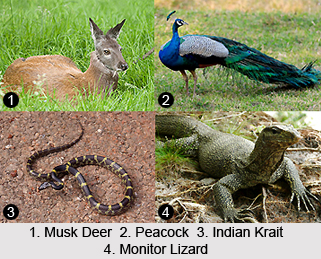Shilli Wildlife Sanctuary is considered to be one of the most picturesque locales of Himachal Pradesh which is based at a distance of nearly 5 kilometres away from Solan District. Shilli Wildlife Sanctuary was set up during 1963 and was aimed at conserving the endangered animals of that time, particularly the Himalayan Black Bear. However, its authorities soon felt the area enclosed by it was not enough to accommodate all the endangered species and on 27th March, 1974 it was re-notified. Thereafter, the area of Shilli Wildlife Sanctuary area was expanded to nearly 2.14 square kilometres. There are different types of flora and fauna, which lure wildlife lovers to this wildlife sanctuary.
Flora of Shilli Wildlife Sanctuary
Tall Deodar and Fir trees dot the region of Shilli Wildlife Sanctuary, which is protected by a fence. In the lower areas of Shilli Wildlife Sanctuary, the inland and outland tourists will come across other species of plants as Fir and Deodar grow at higher elevation. Apart from these, numerous medicinal plants also thrive here, and a research organisation is existent in the Shilli Wildlife Sanctuary which conducts studies on such medicinal herbs and shrubs. A large portion of Shilli Wildlife Sanctuary is covered with Ban Oak and Deciduous Forests.
Fauna of Shilli Wildlife Sanctuary
Besides the Himalayan Black Bear, Shilli Wildlife Sanctuary is filled with various other wild creatures including Brown Bear, Leopard, Jackal, Hyena, Musk Deer, Barking Deer, Bear and several others. Woodcutter, Peacock, Duck, Parrot, Myna, Pheasant and Hornbill are a few of the plenty of birds which survive in the reserve. Wildlife enthusiasts might also catch sight of reptiles like Monitor Lizard, Indian Cobra, Python, Indian Krait, Flying Squirrel and some others. It is said that this sanctuary is amongst the calmest sanctuaries in the entire country.
Shimla and Chandigarh airports are the closest airports to Shilli Wildlife Sanctuary which are based at 28.5 kms and 63.3 kms respectively. The nearest railway station is Solan which can be easily approached from Kalka. And the nearest attraction is Solan District, which was the princely state during early British colonial times.











